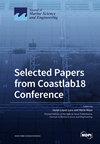Impact Analysis of Welding Sequence to Reduce Weld Deformation in Aluminum Hulls
IF 2.8
3区 地球科学
Q1 ENGINEERING, MARINE
引用次数: 0
Abstract
Aluminum hulls, which are preferred in the marine industry due to their durability, corrosion resistance, and lightweight properties, face serious challenges due to thermal deformation during welding. This study aims to predict and minimize transverse deformations due to welding sequences for a transverse model in the lower part of an aluminum hull. To predict deformations, heat source dimensions obtained from actual weld beads were used as simulation conditions, and various welding sequence conditions were simulated through the developed finite element method (FEM). The simulation results were compared with actual deformation measurements to verify their reliability, and the optimal welding sequence which minimized deformation was derived. The simulation results show that by changing the welding sequence conditions, the maximum displacement can be reduced from a maximum of 52.1% to a minimum of 39.1%, and the effective plastic strain can be reduced from a maximum of 19.6% to a minimum of 4.8%. These results show that adjusting the welding sequence conditions can significantly improve structural integrity by minimizing deformation. The results of this study suggest that the control of the welding sequence can be used to reduce the deformation of aluminum hulls and promote a more sustainable marine industry with improved quality.减少铝制船体焊接变形的焊接顺序影响分析
铝制船体因其耐用性、耐腐蚀性和轻质特性而成为船舶业的首选,但由于焊接过程中的热变形,铝制船体面临着严峻的挑战。本研究旨在预测铝制船体下部的横向模型因焊接顺序而产生的横向变形,并将其最小化。为了预测变形,使用了从实际焊缝中获得的热源尺寸作为模拟条件,并通过开发的有限元方法(FEM)模拟了各种焊接顺序条件。模拟结果与实际变形测量结果进行了比较,以验证其可靠性,并得出了变形最小的最佳焊接顺序。模拟结果表明,通过改变焊接顺序条件,最大位移可从最大值 52.1% 降至最小值 39.1%,有效塑性应变可从最大值 19.6% 降至最小值 4.8%。这些结果表明,调整焊接顺序条件可以最大限度地减少变形,从而显著提高结构的完整性。这项研究的结果表明,焊接顺序控制可用于减少铝制船体的变形,并在提高质量的同时促进更可持续的船舶工业。
本文章由计算机程序翻译,如有差异,请以英文原文为准。
求助全文
约1分钟内获得全文
求助全文
来源期刊

Journal of Marine Science and Engineering
Engineering-Ocean Engineering
CiteScore
4.40
自引率
20.70%
发文量
1640
审稿时长
18.09 days
期刊介绍:
Journal of Marine Science and Engineering (JMSE; ISSN 2077-1312) is an international, peer-reviewed open access journal which provides an advanced forum for studies related to marine science and engineering. It publishes reviews, research papers and communications. Our aim is to encourage scientists to publish their experimental and theoretical results in as much detail as possible. There is no restriction on the length of the papers. The full experimental details must be provided so that the results can be reproduced. Electronic files and software regarding the full details of the calculation or experimental procedure, if unable to be published in a normal way, can be deposited as supplementary electronic material.
 求助内容:
求助内容: 应助结果提醒方式:
应助结果提醒方式:


